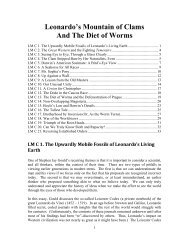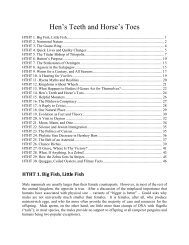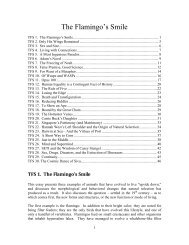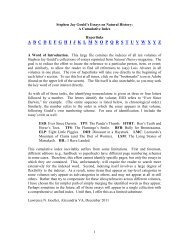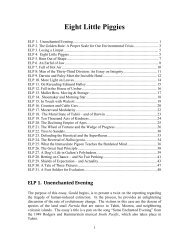Linnaeus, Gould states, did not simply collect and organize raw data in a theory-freeenvironment as Huxley suggests. Linnaeus not only had to create a theoreticalframework to hang his data on, he had to remove other models that impeded a betterunderstanding (thus partially “unmasking nature”). These models typically involved theview that nature was created specifically for humans. One model that Linnaeus displacedbelonged to Ulysse Aldrovandi, who grouped animals by such characteristics as size,utility to man, and supposed possession of human-like qualities (such as wisdom, e.g. theowl). Another, by Conrad Gesner, was based on the Great Chain of Being, theanthropomorphic paradigm that placed man just below angles. [<strong>In</strong> LSM 9, Gould alsoaddresses the efforts of Buffon.] Linnaeus was arrogant (Gould tells us), and mistakenabout the source of the similarity in his groupings, but he did consider his organizingtaxonomy to belong to God rather than Man. His recognition and codification of thestructure of life in its own terms was a necessary step, without which Darwin’s secondunmasking of nature – descent with modification – would not have been possible.DIH 33. Ordering Nature by Budding and Full-BreastedSexualityLinnaeus was successful in grouping animals by closeness of their relationships withother animals [see the previous essay]. However, plants proved to be more difficult toorganize in this way. What he did instead, starting in the 1730’s, was to group plantsbased on the male and female parts of their flowers. Most flowers have one pistil(female) and a distinct number of stamens (male). Linnaeus binned plant life into 24classes, most based on the number of stamens. Some unusual classes consisted of specieswith male and female flowers on different individual plants. One class was reserved forall plants that have no flowers or seeds at all, but reproduce via other mechanisms such asspores. The problem with this approach, as Linnaeus himself recognized, is that it tendsto group plant species that are not very closely related to each other. However, he couldfind no better principle, and this approach served two very important functions: it waseasy to teach, and it was easy to use.Another member of the Enlightenment that swept Europe in the 18 th century was ErasmusDarwin (1731 – 1802), grandfather of Charles Darwin. Erasmus was a well-to-dophysician, thinker, and poet, and a member of the progressive movement of his day. <strong>In</strong>1789, he wrote a 238-page document entitled The Loves of the Plants. <strong>In</strong> iambicpentameter (!), Erasmus poetically describes each of Linnaeus’s 24 plant classes. Sinceflowers are part of the plant’s reproductive system, Darwin uses metaphors relating thepistils to women and the stamens to men, often in the form of stories related to currentevents or to classical literature or mythology. Gould presents over a dozen examples ofErasmus’s highly ornamented prose. For example, of the Iris, in the class of Triandria(one female pistol and three male stamens), he writes:The freckled Iris owns a fiercer flame,And three unjealous husbands wed the dame.44
The descriptions were likely intended to help students or other readers learn andremember the Linnaean classes; Erasmus notes that he was paid to write it. Themetaphors themselves do not, however, produce any additional scientific insight [one ofthe points of the next essay]. On the other hand, they do allow Darwin a forum to presenthis views on evolution (in the pre-natural selection sense), progress, and his rather liberal(for the time) view of human sexuality. Drawing on an article by Janet Browne, Gouldnotes that the sexism inherent in the culture is apparent in Darwin’s writing. As a greatuser of metaphors himself, it is with mixed feelings that Gould pans Erasmus’s use ofthem; but he cannot help but be fundamentally opposed to analogies between humanfeelings or behaviors and the natural world.While Erasmus Darwin was relatively liberal, the motivator of his book – Linnaeus – wasdecidedly conservative, especially about sexual matters. Yet, Linnaeus himself coinedthe term “mammal” for the class of animals that includes humans. Why did he, Gouldasks, identify the group in terms of such a sexually charged body part? He was the firstto do so in this way. Clearly it had to do with the unique manner in which mammalianmothers feed their offspring; but in such a male-dominated world, why emphasize thisuniquely feminine capability? Londa Schiebinger, another scholar whose work Gouldreferences in this essay, makes the case that Linnaeus wanted to emphasize his view thathumans were part of the animal world, and not a separate creation (or even taxonomickingdom) as some of his opponents argued. He assigned humans the genus-speciesidentifier Homo sapiens, with the simple, albeit ambiguous, descriptor: “Know thyself.”DIH 34. Four Metaphors in Three GenerationsGould loved metaphors, as well as words and word origins. He begins with a fewetymological anecdotes from a trip he took to Greece. He discovered that one of thewords he and Niles Eldridge used to describe their theory of punctuated equilibrium –stasis, referring to a period of stability – is used to identify bus stops in Athens. Anotheris the word metaphor itself, which appears on moving vans and luggage carriers; there itmoves literal objects, rather than concepts, from one place to another. After this amusingintroduction, he turns to the body of the essay. He references four metaphors used byErasmus Darwin in his 1789 work The Loves of the Plants [see the previous essay], andfollows this with four metaphors from Charles Darwin’s 1859 Origin of Species. SinceErasmus is Charles’s grandfather, the essay’s title becomes apparent.Metaphors are a powerful tool for conveying ideas. Like any conceptual tool, they canimpede intellectual understanding as easily as it can assist it. Metaphors can bemisleading as well as insightful; they can also be ineffective as well as useful. Gouldcharges that Erasmus’s metaphors are of the ineffective variety. They are long andflowery (no pun intended), but do not enlighten the reader scientifically, or provide anyadditional insight into the subject. To be fair, it was not his intent to do so; he wassimply trying to illustrate Linnaeus’s taxonomic structure in an artistic and entertainingway. Charles has a much more difficult task: to convey a different way of thinking aboutnature. He employed metaphors to clarify his new and unorthodox viewpoint. Gould45
- Page 4 and 5: cloud (“nebula”) of gas and dus
- Page 6 and 7: goodness, and is both intelligent a
- Page 9: The second news story involves the
- Page 12 and 13: key ways. Prior to 1994, no fossil
- Page 14: DIH 11. Lucy on the Earth in Stasis
- Page 17: directly resulted in a mass extinct
- Page 20 and 21: Edgar Allan Poe, it turns out, wrot
- Page 22 and 23: things male, while the beautiful is
- Page 24 and 25: interest, until the entrepreneur of
- Page 26 and 27: essay is that scientists, for all t
- Page 28 and 29: DIH 23. The Smoking Gun of Eugenics
- Page 30 and 31: half-Jewish meant Jewish, while qua
- Page 32 and 33: Darwin’s theory, like Adam Smith
- Page 34 and 35: What might a better definition of t
- Page 36 and 37: type of soil, amount of rain, and s
- Page 38 and 39: Case Four, in Gould’s words, is
- Page 40 and 41: multiplying his findings by the num
- Page 42 and 43: other departments, something that r
- Page 46: greatly prefers these metaphors, on




